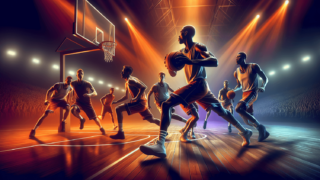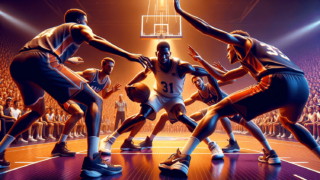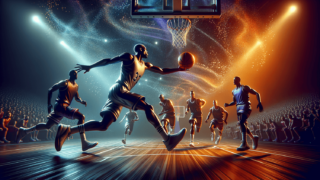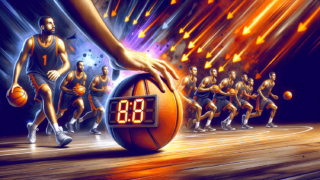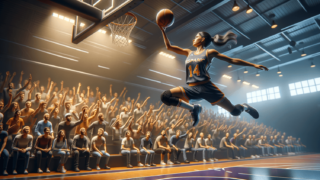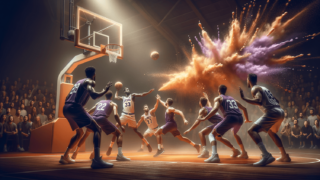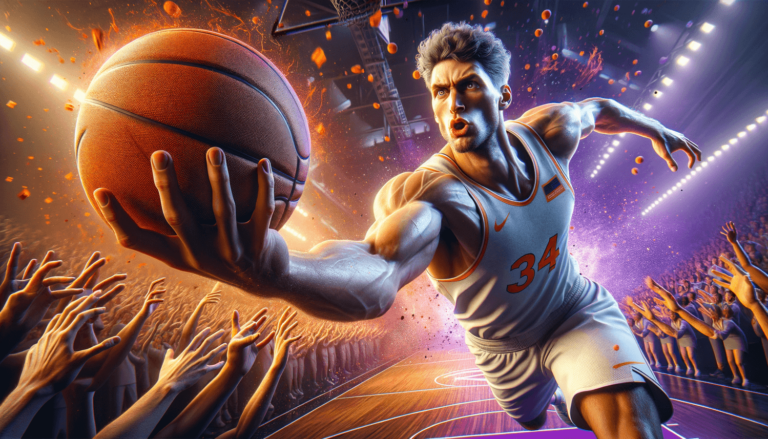
Basketball’s Palming Violation: What You Need to Know
Written by: Basketball Universe
Last updated:

Welcome to the world of basketball, where every move counts and precision is vital! Today we’ll delve into an often misunderstood but essential rule: palming violations. Get ready to sharpen your hoops knowledge as we break down the mechanics, its impact on the game, and tips to avoid this notorious infringement. We promise to keep it fun, professional, and pack it full of useful information. So lace up those sneakers, and let’s learn all there is to know about basketball’s palming violation!
Basketball’s Palming Violation: What You Need to Know
A palming violation, also known as ‘carrying,’ occurs in basketball when a player illegally grips or places their hand under the ball while dribbling. This action disrupts the natural flow of the game and gives the player an unfair advantage. To avoid a palming violation, players must ensure their hand remains on top, side, or front but never under the ball while dribbling, maintaining constant contact as the ball moves.
The Origin and History of Palming Violations
Like most basketball rules, the palming violation has an interesting origin story. The rule was introduced in the early years of the game to prevent players from gaining an unfair advantage while dribbling. It evolved as the game grew more competitive, with players looking for creative ways to outsmart their opponents. Let’s delve into the historical context of palming violations and explore how it has shaped modern basketball.
Early Beginnings
Basketball was invented in 1891 by Dr. James Naismith, who precisely outlined the essential rules of the game. As the competition became fiercer, players began experimenting with unorthodox dribbling techniques, attempting to gain more control over the ball. In response, authorities recognized the need to standardize dribbling regulations, which led to the birth of the palming violation.
Addressing the Offense
In the early days, palming wasn’t strictly enforced compared to other basketball rules, partially due to the inconsistency among game officials. However, as the game progressed and advanced skills were showcased, the violation became more noticeable, highlighting the need for stricter regulations. Now, with more defined guidelines in place, consistency in officiating palming violations has significantly improved.
Understanding the Palming Violation
To grasp the nuances of a palming violation, we must first understand the mechanics involved in the offense. As a player dribbles the basketball, their hand should always maintain contact with the top, side, or front of the ball. Placing a hand underneath the ball while dribbling constitutes a violation, as it allows for better control, disrupting the natural flow of the game.
Identifying the Offense
Determining a palming violation can be challenging, even for the most experienced officials. The key to identifying the offense lies in closely observing the player’s hand movements relative to the ball. Watch for any indication that a player is gripping the ball or moving their hand underneath it, which could signal a violation. Note that seeing the offense in real-time can be challenging, so officials often rely on a combination of visual cues and well-honed experience to make the call.
Impact of Palming Violations on Overall Gameplay
Strict enforcement of the palming violation rule serves to maintain fair competition by ensuring players adhere to established dribbling techniques. Failing to penalize carrying can result in a significant imbalance in the game, favoring skilled ball handlers who can exploit this unfair advantage. By adhering to core basketball rules, like the palming violation, the game remains fair and engaging for all participants.
Advantages of Avoiding Palming Violations
Players that consistently avoid palming violations demonstrate their commitment to mastering fundamentals while remaining within the constraints of the game. By developing legal dribbling techniques, players can compete successfully without exploiting the rules, ensuring credibility and sustaining the integrity of the sport.
Techniques to Prevent Palming Violations
Effective dribbling without incurring a violation involves practicing the correct dribbling mechanics. We’ve outlined several techniques that can help you avoid palming violations and improve your skills on the court.
Correct Hand Positioning
Whether you’re bouncing the ball with your fingertips or cupping it in your palm, proper hand positioning is crucial. Keep your hand on top, side, or front of the ball to avoid calls for carrying. Vary the force you use when making contact — a firm push is ideal for propelling the ball, while gentle control keeps it within reach.
Consistent Dribbling Rhythm
Establishing a consistent dribbling rhythm minimizes the likelihood of committing a palming violation. Find a pace that works for you and practice dribbling at different heights and speeds while maintaining a regular rhythm. This will keep your hand in constant motion, decreasing the odds of accidentally touching the bottom of the basketball.
Refining Ball Control
To lessen the temptation to carry, focus on improving your overall ball control. Develop your dribbling technique using your fingers and incorporate various types of dribble, such as low or high dribbles, to maintain better control over the ball without triggering a palming violation.
Dispelling Common Myths About Palming Violations
As with most misunderstood rules, palming violations carry their fair share of misconceptions. Let’s set the record straight by dispelling some common myths surrounding this infraction.
Myth: It’s Only a Violation if the Referee Calls It
While the rule is subject to the referee’s interpretation, it’s crucial to remember that a palming violation occurs when the hand is placed under the ball while dribbling — regardless of whether the official calls it or not. Strive to maintain proper dribbling technique, and don’t rely on the possibility that officials might not notice the infraction.
Myth: Palming Violations Mostly Occur in Amateur Basketball
Palming violations are not exclusive to amateur games; they can occur at any level of play. Instinct might lead players to grip the ball tightly during intense moments, but refining technique and avoiding carrying can make a world of difference in performance at any competitive level.
Notable Instances of Palming Violations in NBA Games
Palming violations have made headlines on countless occasions, even at the highest levels of the sport. Let’s dive into a few notable instances that underscore the significance of this rule even in professional basketball.
Allen Iverson’s Signature Crossover
Allen Iverson’s killer crossover became a hallmark of his career, earning him legions of fans as he left his opponents’ ankles broken in his wake. However, many argue that the move occasionally constituted a palming violation. Iverson’s crossover would sometimes involve a hand placement briefly underneath the ball, an interpretative gray area that has sparked endless debate among basketball enthusiasts.
Tim Hardaway’s UTEP Two-Step
The UTEP Two-Step, a crossover move introduced by Tim Hardaway, is another classic example of controversial hand placement during dribbling. Like Iverson, Hardaway’s technique raised eyebrows when he appeared to carry the ball during the step. However, officials rarely called the violation on him, furthering the debate on the enforcement of palming violations in professional games.
Conclusion
The palming violation is a critical aspect of the game that regulates fair play and maintains the flow of basketball. By understanding its history, mechanics, and impact on gameplay, players can develop effective dribbling techniques that adhere to the rules while enhancing their overall performance. As you progress through your basketball journey, remember to consistently practice your dribbling skills and strive for excellence within the boundaries of basketball rules. Happy dribbling!
How Palming Violations Are Called in Different Leagues
Though the basis of palming violation remains the same, the criteria for what is called a violation can differ from league to league, ranging from professional leagues like the NBA to youth and recreational leagues. Understanding how the rule is enforced in different leagues can provide a comprehensive perspective on the palming violation.
National Basketball Association (NBA)
In the NBA, palming violations are called less frequently than in other basketball leagues, leaving more room for interpretation. Due to the fast-paced nature of professional games and the exceptional ball-handling skills of NBA players, referees tend to pay more attention to gameplay and can overlook minor hand positioning deviations.
National Collegiate Athletic Association (NCAA)
The NCAA maintains a relatively stricter policy on palming violations compared to the NBA. In college basketball games, referees are more vigilant when it comes to identifying a hand slipping underneath the ball, following a more conservative interpretation of the rule.
High School and Youth Leagues
At the high school and youth league levels, palming violations are often more strictly enforced. Coaches and referees emphasize the importance of teaching proper dribbling techniques to younger players, fostering good habits and fair play from an early stage. This ensures that players develop fundamental skills and adhere to basketball rules as they advance in their basketball careers.
Tips for Coaches to Teach Proper Dribbling Techniques
As a coach, you play a critical role in helping your players develop their dribbling skills while avoiding palming violations. Here are some tips on how you can effectively instruct your players in proper techniques to minimize the risk of carrying.
Emphasize Hand Positioning
Teach your players the importance of keeping their hand on top, side, or front of the ball not only during practices but also in actual games. When reviewing game footage, point out instances where hand positions could put them at risk of committing a palming violation, and offer actionable advice to improve their technique.
Drills for Ball Control
Introduce drills that focus on ball control, such as zigzag dribbling or dribbling with alternate hands. These exercises can help players become more comfortable with keeping their hand in constant contact with the ball and discourage them from subconsciously slipping their hand underneath during gameplay.
Building Confidence and Decision-Making
Refine your players’ decision-making skills by incorporating situational dribbling exercises that require them to react to various scenarios. Teaching cohort approaches, game-like situations, and positional decision-making will build confidence in their dribbling skills and reduce the likelihood of committing palming violations.
Recap of Basketball’s Palming Violation
The palming violation is an essential rule that maintains fairness and effective competition among basketball players. By understanding the history, mechanics, and individual impact of the violation, players and coaches can develop legal dribbling techniques that promote adherence to basketball rules and enhance overall sportsmanship across different leagues. Stay informed about the nuances of the game and continue working on those dribbling skills to excel on the court.
FAQ: Frequently Asked Questions on Basketball’s Palming Violation
Discover answers to the most frequently asked questions about the palming violation in basketball. This FAQ section addresses common concerns and clears up misconceptions, providing you with a comprehensive understanding of this particular basketball infraction.
1. How do I know if I’m committing a palming violation?
If your hand is placed under the ball while dribbling, you may be committing a palming violation. To prevent this, ensure your hand remains on the top, side, or front of the ball, maintaining constant contact during dribble motions.
2. Can a palming violation occur without dribbling the ball?
No, palming violations specifically pertain to dribbling. While it’s possible to momentarily grip or palm the ball during other actions, such as catching a pass or shooting, those situations do not constitute a palming violation.
3. Are certain players more prone to palming violations?
Palming violations can occur at all skill levels; however, inexperienced players and those with weaker dribbling skills are more likely to inadvertently place their hand underneath the ball while trying to maintain control during a game.
4. What’s the penalty for committing a palming violation?
If a player is called for a palming violation, their team will lose possession of the ball, and the opposing team will be awarded the ball at a designated spot out of bounds.
5. How can I avoid committing a palming violation?
To avoid committing a palming violation, focus on proper hand positioning, establishing a consistent dribbling rhythm, and refining ball control through practice and various dribbling exercises.
6. Are palming violations more common in certain leagues?
Palming violations can be more frequently called in some leagues, such as high school and youth leagues, compared to professional leagues like the NBA. However, the rules regarding palming violations remain consistent across different basketball leagues.
7. Can NBA players get away with palming violations more easily?
NBA players may sometimes get away with palming violations due to the fast-paced nature of the game and the difficulty of spotting every infraction in real-time. However, NBA referees still enforce the rule when they notice a violation.
8. Can a player be ejected from a game for repeated palming violations?
No, a player cannot be ejected from a game solely for repeated palming violations. However, if a player is disrespectful or disruptive in response to being called for a violation, they could be subject to technical fouls or ejection based on their conduct.
9. Does a palming violation count as a personal or team foul?
A palming violation is not counted as either a personal or team foul. It is specifically categorized as a ball-handling violation, resulting in a loss of possession for the offending player’s team.
10. What other common basketball violations are closely related to palming?
Double dribble and traveling are two other common basketball violations related to ball-handling. A double dribble occurs when a player touches the ball with both hands simultaneously or stops dribbling and starts again, while traveling involves taking too many steps without dribbling the ball.
Featured Posts
- No pillar pages found.
